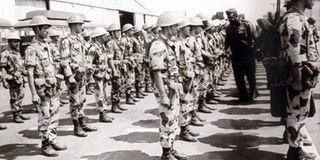When Gaddafi sent desert commandos to fight in tropical Masaka

President Amin inspecting Libyan troops at State House, Entebbe
Gaddafi in Uganda looms both large and small; there is the conspicuous and the not-so-conspicuous. There is the grand mosque and the palace, the street and the fuel outlets, the bank and the housing conglomerate. Then there is the mass grave. In a little clearing on the edges of Budo hill, 12km east of Kampala, lie the remains of two dozen or so Libyan soldiers, victims of the misadventures of Muammar Gaddafi. They were killed in battle, having been sent to Uganda as part of an expeditionary force to save Idi Amin’s regime in early 1979.
As Amin’s forces beat a hasty retreat from the southern frontline in January, with the Tanzanian army and the Ugandan rebels pushing hard, the Ugandan President called for assistance from Tripoli. Bernard Rwehururu, an officer in the Uganda Army, records in his book Cross to the Gun that the so-called Suicide Regiment had been tasked with defending Masaka town in an axis that covered Mutukula Road, Mbarara Road and Bukakata-Nyendo Road. The enemy was advancing towards Kalisizo, when Gaddafi sent his troops. They were desert commandos, sent to fight in the tropical environment of Masaka. What happened next was a debacle.
“The arrival of the Libyan desert commandos was as surprising as it was annoying because we had made it all along clear to Amin and the entire Army top brass that all we needed was artillery fire power to neutralise the enemy’s Katyusha and not the personnel. Communication was the biggest problem. They could neither communicate in English nor Swahili. Attempts to use Nubian which is more like broken Arabic hit a dead end because they could not understand the dialect. We resorted to communicating by hand.
“Another problem was in the dressing and the arms that the Libyan commandos opted to use. Their clothes were clearly not for jungle warfare. Instead of arming themselves with assault rifles like G3s and AK47s, they had light arms like Uzi guns and a wide range of machine pistols. We did not have any way of informing them that their clothes and arms were going to work against them, so we simply let them go to the front. They joined our forces that were waiting for the enemy in Kalisizo. The enemy descended upon the area in full force. The battle was hot for both our troops and the Libyans, who suffered because of their failure to comprehend withdrawal orders issued in Swahili.
“The following morning when some of them came back to Masaka after the fall of Kalisizo, they were a sad sight. Some were dead and many of them were injured. It was a pitiful scene watching those who were lucky to escape without any injuries tearfully carrying their wounded and dead colleagues off their small trucks,” notes Rwehururu.
A month or so later in late March, as they retreated towards Kampala, the Libyan commandos took up a strategic position on Budo hill, that had a 360 degree view of Kampala, Entebbe and Mpigi. They set up camp just outside the school fence of King’s College Budo. The school authorities had barely evacuated the student community, and the rest of the hill’s population. It is here that the advancing forces of Tanzanian troops and Ugandan exiles engaged them in battle days before Kampala fell. When the school re-opened in June, the graves were still fresh, though the strategic position had been taken over by the victorious Tanzanians, who then co-existed with the school population.
When Amin took power in Uganda in 1971, he had the backing of, amongst other Western powers, the Jewish State of Israel. Gaddafi, who had also ascended to power through a military coup two years before, set about making his mark in Africa. He sponsored a number of countries to break ties with Israel. When Amin expelled the Israelis in 1972, the Libyans came in to fill the void.
Henry Kyemba relates Amin’s urgent need for cash in early 1972. He outlines, in his regime-defining book, A State of Blood that: “Britain always wanted feasibility studies before funds were allocated (to Uganda). Similarly, the Israelis gave serious consideration to new ideas strictly on merit. That was not the kind of money Amin wanted. He saw his chance while on a state visit to West Germany in February 1972.
Shortly before his return he decided to visit Gaddafi. Since he was flying an Israeli jet, many (Ugandan) ministers were shocked at the prospect of his dropping in on an extremist Arab dictator, but he went, met with Gaddafi, and received promises of massive financial and military aid. It was an attractive prospect for Gaddafi as well, for he was suddenly presented with an opportunity to have Israel thrown out of an African country”. Thus began an enduring love affair between Gaddafi’s Libya and Uganda.




